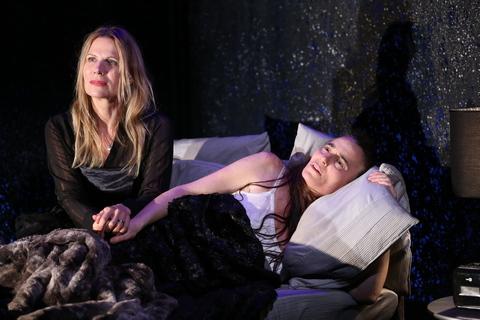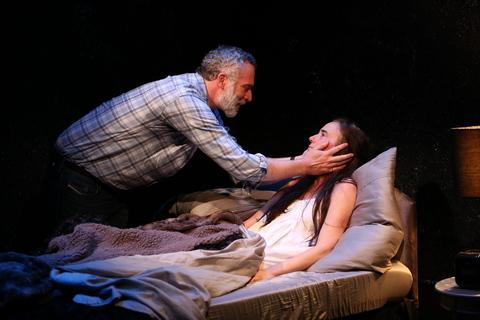Woman and Scarecrow
Playwright Marina Carr’s debut at the Irish Repertory Theatre is an uneven ode to the inevitable.

Pamela J. Gray and Stephanie Roth Haberle in a scene from Marina Carr’s “Woman and Scarecrow” at the Irish Repertory Theatre (Photo credit: Carol Rosegg)
In Marina Carr’s death-obsessed Woman and Scarecrow, a terminally bedridden Irish mother rages both against the dying of the light and herself, as she remembers a life filled with far more regrets than happiness. It’s not clear what’s physically wrong with her, though it appears the nameless Woman (Stephanie Roth Haberle) is essentially willing herself into the grave. At times, it feels like the play is willing the audience there, too, for a cathartic confrontation with our own mortality. Given this bent, it’s particularly appropriate, then, that the New York premiere of this 2006 work is being performed in the Irish Repertory Theatre’s cramped, underground studio space, which tends to give one the sense of having been recently buried.
While awaiting the inevitable, the Woman contentiously converses with a strange figure known as the Scarecrow (Pamela J. Gray), whose essence Carr leaves in doubt. Perhaps she has been a life-spanning supernatural companion. Or maybe she is nothing more than a medicinally induced hallucination. Either way, the Scarecrow, who only the Woman can see, is a harsh truth-teller, refusing, at the end of it all, to let the Woman take solace in what most defined her life: a marriage that produced nine pregnancies and eight children. As the Woman desperately tries to remember her family in the best possible light, the Scarecrow unleashes acerbic gems like “You used up everything you had giving everyone what they wanted.”

Dale Soules in a scene from Marina Carr’s “Woman and Scarecrow” (Photo credit: Carol Rosegg)
Once in a while, Carr intimates that, in fact, what the Scarecrow represents is the Woman’s true self, which she has wasted on an unworthy man whose infidelities appear to have been more numerous than his offspring. It’s a familiar tale that has left the Woman completely empty and the Scarecrow thoroughly enraged, as she’s had to helplessly watch as the Woman let her potential for personal fulfillment dwindle to nothing.
Still, the Scarecrow is not just a font of I-told-you-so’s; she’s also the Woman’s fearless protector against what Carr aptly terms The Thing in the Wardrobe, a birdlike creature apparently intent on taking the Woman not so gently into that good night. Director Ciarán O’Reilly and his inventive production team delight in building the tension around this bête noire, with Michael Gottlieb’s lighting and Ryan Rumery’s sound adding rich chills to the occasional appearance of a razor-sharp talon from set designer Charlie Corcoran’s foreboding cabinet of horrors. To be honest, their work is so good, it made me dread seeing the monster in full, not because I’m a fraidy cat (though I certainly can be) but, rather, because I feared the letdown more than the reveal. But, as evidenced by the gasps around me, Whitney Locher’s costume for the long-awaited visual coup de grâce managed to meet or exceed imaginative expectations.
Unfortunately, O’Reilly’s heavy reliance on the production team is also indicative of a significant problem: the play is repetitive. Despite finding new, and often lovely, poetic ways to convey the centrality of death to life, Carr’s thoughts and arguments quickly begin to sound like the same melody over and over again, just in a different key. O’Reilly tries to distract us from this fault by giving the Gottlieb-Rumery-Corcoran trio creative free rein; the deathbed, for example, frequently looks like it’s floating somewhere in the cosmos. But the images invariably keep giving way to the words, which, though beautiful, grow tiresome by the second act.

Aidan Redmond and Stephanie Roth Harberle in a scene from Marina Carr’s “Woman and Scarecrow” (Photo credit: Carol Rosegg)
Carr apparently knows that she is running on intellectual fumes, too, and, so, seemingly as an afterthought, tries to flesh out her dying heroine’s life, offering up brutally naturalistic scenes between the Woman and her philandering husband (Aidan Redmond) as well as wonderfully comic ones with the congenitally disapproving aunt (Dale Soules) who raised her after her mother’s passing. While Redmond and Soules shine in these supporting parts, Haberle struggles with the impossible tonal shift Carr’s writing requires of her. She simply can’t pull off being meekly at death’s door one moment while having a full-throated, no-holds-barred fight with her husband the next.
If Woman and Scarecrow were longer, maybe Carr could have more effectively meshed together life and death. But that would have required caring about the former as much as the latter, which, at least in this play, I don’t think she does.
Woman and Scarecrow (through June 24, 2018)
Irish Repertory Theatre
Scott McLucas Studio Theatre at The Irish Repertory Theatre, 132 West 22nd Street, in Manhattan
For tickets, call 212-727-2737 or visit http://www.irishrep.org
Running time: two hours and 15 minutes including one intermission






Leave a comment